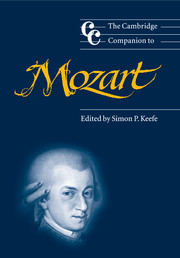17 - Performance practice in the music of Mozart
from Part IV - Performance
Published online by Cambridge University Press: 28 September 2011
Summary
Until the second half of the nineteenth century composers tended to work within a lingua franca, which did not prevent their music from having a discernible individuality. Their personalities are evident both in matters of style and in peculiarities of notation and terminology. These tend to be overlooked in conservatory training, which dispenses general definitions of terminology with presumed universal validity. The primary sources of performance practice information for Mozart and other eighteenth-century musicians are the treatises, particularly those of Mozart's father on violin playing and that of C. P. E. Bach on keyboard playing.
What follows is an attempt to cover the principal areas of idiomatic performance practice in Mozart. Given the constraints of space, emphasis will be placed upon the relationship between Mozart's notation and its execution. The treatment of individual domains and instruments is drawn both from the treatises and the author's study of Mozart's notational practice.
Society, tempo and character
Mozart's music incarnates a cosmopolitan vernacular depicting a wide range of dramatic and emotional situations, which are intimately bound up with the social conventions of his day. There is scarcely a musical gesture, from the courtly and martial march to the sighing appoggiatura, that is not related to societal relationships and functions, physical gestures, or emotional archetypes. It is Mozart's singular achievement to have enriched this universally understood vocabulary with uncanny acuity of perception in matters of human motivation and character, supported by a sophisticated control of dramatic and structural events from the smallest detail to the largest arc.
- Type
- Chapter
- Information
- The Cambridge Companion to Mozart , pp. 227 - 245Publisher: Cambridge University PressPrint publication year: 2003
- 2
- Cited by



